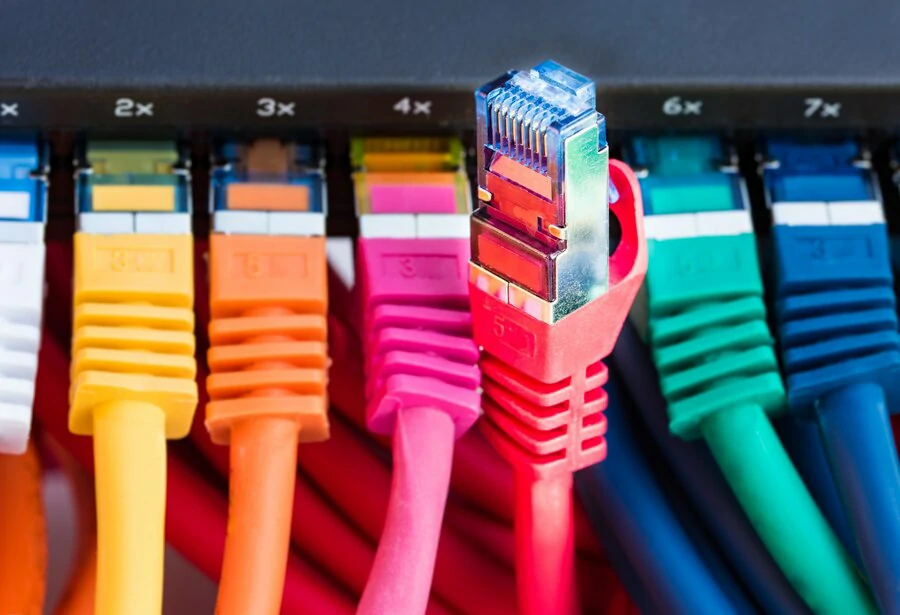Back in the early 1970s, it was only Xerox Corporation that invented the Ethernet, but it has been years and many transformations have been made to reach the sophisticated high networking technology we see today. The speed of Ethernet has also been improving; from the earlier speed of 2.94 Mbps, the technology has seen common speeds of 100 Gbps, and that even includes new 400 Gbps solutions. Demand for Ethernet has always increased due to faster speeds and better performance for networks. Ethernet was first used for computers in a local area network in the eighties, and this trend started growing and has not stopped even today.
The Reasons Why Ethernet Still Has Many Users
Several things make Ethernet relevant, one of them being its capacity to facilitate fast and dependable connectivity, which is very important for businesses and individual clients. Unlike wireless technologies, connectivity through Ethernet is limited, and therefore a more secure connection can be provided. Apart from that, due to the expandable Ethernet, it has adopted too many devices and applications, which allows it to be used for different networking purposes, be it a tiny house network or a huge enterprise data center.
Power over Ethernet (PoE)
Power over Ethernet (PoE) is a technology that allows extending electric power to devices along with data using Ethernet cables. This means that instead of having a power supply unit to run devices such as IP cameras, VoIP phones, and wireless access points, among other devices, one only connects a data Cat 5 cable. Due to its ease of use and affordability, PoE is also being embraced in smart building technologies and other IoT devices. The most recent development in PoE technology, such as PoE++, is capable of providing an even higher power supply to the devices and more stimulating applications.
Ethernet & Internet of Things
With the escalating number of IoT devices in the installed base, Ethernet focuses on providing the connectivity backbone. Thanks to its reliability and security, Ethernet is well positioned in different IoT networks, however, most especially in industrial environments where connections need to be both stable and secure. Equipped with such features as low latency for the transfer of huge amounts of information, Ethernet is ideal for real-time applications that are essential in IoT systems.
The Ethernet in 5G Networks

The rise of 5G networks has caused a surge in demand for bandwidth capacity and latency reduction, which are some of the best features of Ethernet. With the integration of Ethernet networks, structures will be erected that ensure complete 5G services without any interruption in connectivity or data transfer. The convergence of Ethernet with 5G is expected to improve the efficiency and dependability of the networks, which will cater for a variety of services, including self-driving cars and smart cities.
Security Advancements in Ethernet
Due to the rising malicious attacks, an enhanced level of security is the main focus while designing a network. To this end, the Ethernet technology in use today is gradually being enhanced to incorporate modern security practices such as data encryption and authorization of user access through passwords, among other technologies. These are essential elements in the preservation of confidential information and ensuring seamless communication over a network in situations such as those experienced in banks and government offices.
Green Ethernet
The aspect of environmental preservation is gaining popularity in the processes of designing and developing new technologies. The Green Ethernet technology is aimed at reducing the total power consumption of a network device by controlling the power drawn depending on whether there are active data packets being transmitted over the network. This results in reduced operational costs while at the same time offering greener networking solutions. Systems that incorporate features such as Energy Efficient Ethernet (EEE), which cut down power usage automatically during idle data periods, are now being produced.
Challenges Facing Ethernet
Along with numerous benefits, there are some concerns regarding the future adoption of Ethernet. These include the expenses related to upgrading the essential network infrastructure for backhaul, especially among small and medium enterprises (SMEs), as well as regular updates to accommodate the ever-increasing need for faster and more secure networks. In addition, due to the increasing trend towards wireless environments, Ethernet is slowly becoming obsolete as the corporate and end-user quest for more adaptable network solutions.
The Role of Ethernet in Cloud Computing

Cloud computing technology is heavily reliant on Ethernet as a fundamental infrastructural element since it enables the high-speed capacity that is essential in data centers as well as cloud service offerings. There is an increased demand for Ethernet connections, especially the high-performance ones, as most of the business operations are moving to the cloud. This is ideal for cloud environments that require fast data transfer and processing owing to Ethernet capacity and the ability of sprawling out to cater for enormous data.
Ethernet for Small and Medium Enterprises (SMEs)
For SMEs, Ethernet networks present an affordable and dependable option. It presents the bandwidth and capabilities for the applications to span geographically as well as providing plain internet connections, VoIP, and even enterprise cloud applications. Due to Ethernet’s dependability and management simplicity, it is a suitable technology for SMEs aiming at building a strong and trustworthy network infrastructure.
Future Technologies Shaping Ethernet
There are several up-and-coming technologies that will influence the future of Ethernet. In these ones:
- Terabit Ethernet: The purpose and particulars of terabit Ethernet technology development are to provide even greater data transfer speeds with the increasing bandwidth demand for datacenters as well as high-performance computing.
- Quantum Networking: Innovations in quantum mechanics will one day make it possible to integrate Ethernets with quantum networks. It will require the evolution of Ethernet standards to cater for new demands of high-speed and secured data transfer.
- Optical Ethernet: Employing optical fibers in the place of twisted or unshielded cables in Ethernet connections will enhance the speed while eliminating latencies for these applications, for instance, video on demand and bulk data transport.
Ethernet Standards and Protocols

Today’s technological era has a number of standards and protocols governing Ethernet connectivity, and they are important in ensuring that devices connected have their connections compatible. The IEEE 802.3 specifications remain the most important milestones of the Ethernet technology since they give a clear outline of the physical and data link bases. In the course of time after the introduction of Ethernet standards, there has been a driving force that has continued to improve the performance with speed and efficiency, and of late on the developments have been on 400 Gbps and 800 Gbps Ethernet.
Conclusion
The lasting significance of Ethernet is evident in the discourse of its technological advancement in the present era, whereby… With the current offering in cloud data storage services, amongst many others, IoT devices and 5G network-connected devices are dependent on the proper function of Ethernet. There is strong evidence that Ethernet will persist as one of the constituent parts of the worldwide network structure, connecting people and allowing new services and applications due to the emergence of phenomena and conceptualizations horizons of development.
FAQs
What do you differentiate between Ethernet and Wi-Fi?
Ethernet is a wired connection that is relatively faster, more reliable, and more secure compared to Wi-Fi, which is more convenient but has the odds of operating at lower speeds and could be affected by interferences given that it relies on no wires.
In what way does Ethernet speed up the performance of a network?
The high bandwidth of an Ethernet network enables easy transmission of data over long distances without noticeable time delay, hence its relevance in system and networking technology, which is data hungry.
What are the key factors hindering the transition to next-generation Ethernet?
The most important problems are high capital expenditures for system upgrades, the need for backward compatibility with existing equipment, and growing demand for advanced protection measures against hacking attacks.
Can Ethernet be used in networks of houses?
Of course, Ethernet can be used in home networks, particularly those that are inclined towards the use of stable and high-speed connections, for instance, gaming and watching online videos or even teleworking.
What are the gains of green Ethernet to the environment?
This branch of technology, known as ‘Green Ethernet,’ controls power consumption in accordance with the activity level on the network, which in turn minimizes costs and fulfills environmentally friendly objectives.




